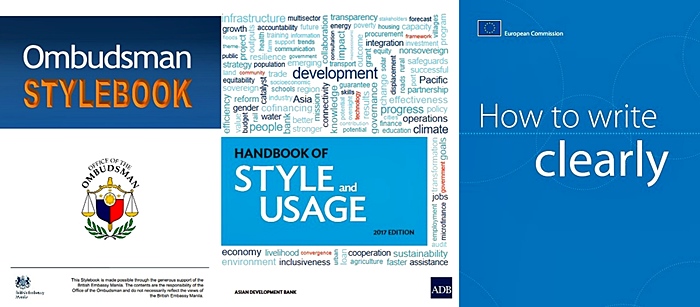The Civil Service Commission should create or adopt a style guide that will be used by all government offices. A. A style guide for publications (newspapers, magazines, websites) and for communications of government offices and private organizations usually contains the following:
A. A style guide for publications (newspapers, magazines, websites) and for communications of government offices and private organizations usually contains the following:1. Conventions or standards for spelling, punctuation, capitalization, abbreviation, quotation, scientific or technical terms, numerals, formats of documents, etc.
2. Conventions or standards for grammar and writing
As far as I know, there’s no prescribed style guide that’s currently being used in government offices in the Philippines. Thus, communications may vary in format and writing standards from one government office to another. My suggestion is for the Civil Service Commission to create or adopt one style guide to be used by all government offices.
(The Department of Interior and Local Government may also require all LGUs to use this style guide.)
The two most-commonly used style guides are AP (Associated Press) for journalism and CMOS (Chicago Manual of Style) for academic writing. Rather than starting from scratch, the CSC can adopt, combine, and revise the existing style guides.
As a quick solution, however, the CSC can adopt the Stylebook of the Office of the Ombudsman. This excellent style guide is the product of a writing seminar sponsored by the British Embassy (Manila) several years ago; it adopted, among others, the good writing guidelines from Bryan Garner’s book “Legal Writing in Plain English.” This style guide is available for download at
https://www.ombudsman.gov.ph/docs/publication/Ombudsman%20Stylebook.pdfWith the excellent Ombudsman’s Stylebook as its starting point, the CSC can adopt and integrate (as annexes, for example) the good writing guidelines from the following style guides or publications:1. “Clear Writing” guidelines from the Asian Development Bank Handbook on Style and Usage, 2017 edition (pages x to xix) at
https://www.adb.org/sites/default/files/institutional-document/31385/hsu-2017.pdf2. “How to write clearly” from the European Commission at
https://publications.europa.eu/en/publication-detail/-/publication/c2dab20c-0414-408d-87b5-dd3c6e5dd9a5/language-en3. “A Plain English Handbook” from the US Securities and Exchange Commission at
https://www.sec.gov/pdf/handbook.pdf4. Federal plain language guidelines at
https://plainlanguage.gov/media/FederalPLGuidelines.pdf Perhaps, the CSC can organize a committee that will come up with this style guide. The committee can be composed of CSC officials and staff, with external resource persons such as Jose Carillo, the grammar guru of the Philippines.B. Like I said, adopting the excellent Ombudsman’s Stylebook is a quick solution for the CSC. Having said this, I must add that I have some reservations about certain portions of the Stylebook.
1. The Stylebook says about “shall” on page 60: 2.4.7. To reduce the word count, try deleting shall—this is said to be the ―true symbol of legalese.This section misquotes Bryan Garner’s admonition to avoid using “shall” in legal writing; he certainly did not suggest avoiding “shall” in order to reduce the word count.
Garner discusses in his book cited above that “shall” is ambiguous and has been interpreted by the courts, including the US Supreme Court, in many ways — must, may, will, is. Please read “Shall We Abandon Shall?” by Garner at
http://www.abajournal.com/magazine/article/shall_we_abandon_shall2. On the “passive voice,” the Stylebook in a footnote on page 43 says: “Garner prefers the active voice: ―Prefer the active voice over the passive (Tip No. 9).”Using the active voice rather than the passive voice is more than just a preference. Numerous cases in the US have been decided by courts against parties who used the passive voice in their pleadings, as discussed by Mark Cooney in the Michigan Bar Journal (June 2005). Examples:
Coroles v Sabey, 79 P3d 974, 981 (Utah App 2003)
J & A Vending, Inc v JAM Vending, Inc, 757 NYS2d 52, 55 (2003)
Castro v Hastings, 74 Fed. Appx. 607, 609 (CA 7, 2003)
Zito v Leasecomm Corp, No. 02 Civ. 8074 (GEL), 2003 WL 22251352, at *10 (SD NY Sept 30, 2003)
In re MJB, 140 SW3d 643, 656 (Tenn App 2004)
United States v Wilson, 503 US 329, 334–35 (1992)
DaimlerChrysler Serv No Amer, LLC v State Tax Assessor, 817 A2d 862, 865 (Me 2003)
Arlington Educ Ass’n v Arlington School Dist No. 3, 34 P3d 1197, 1200 (Or App 2001)
3. The Stylebook says about the “serial comma” (also known as “Oxford comma”) on page 63:3.2.3. Use commas to separate items in a series (three or more items). Such commas are called serial commas. If the last two items in the series are obviously different from each other, do not insert a comma.The Oxford comma (aka serial comma) is perhaps the most divisive issue in grammar. But Garner in his book cited above recommends the use of the serial comma, without the qualification mentioned in the 2nd sentence of the Stylebook cited above. He says in
https://www.lawprose.org/lawprose-lessons-67-68/What’s the most frequent punctuation error that transactional lawyers make?
Answer: Failing to use the serial comma (aka the “Oxford comma”). Its omission is a mistake in legal instruments because litigable ambiguities often result.An example of “litigable ambiguity” that Garner mentions is illustrated by the 2017 case of “O'Connor v. Oakhurst Dairy, No. 16-1901 (1st Cir. 2017) involving milk-truck drivers from Maine. Please read:
“Observations on the Oxford comma” by John Hightower at
https://legalwritingeditor.com/2017/03/22/observations-on-the-oxford-comma“Oakhurst Dairy’s $5M Settlement Driven by Grammar Rules” at
https://bnanews.bna.com/daily-labor-report/oakhurst-dairys-5m-settlement-driven-by-grammar-rules“Dairy Farmers & a Missing Comma: O’Connor v. Oakhurst Dairy” at
http://jlpp.org/blogzine/dairy-farmers-a-missing-comma-oconnor-v-oakhurst-dairy/(C) The proposed style guide must require the use of Plain English in all government communications. For resources and interactive exercises on Plain English, please surf to “Plain English, Plain Language, or Clear Writing for journalism, law, business, science, academic and general writing” at
https://plain-english-resources-and-exercises.netlify.com/